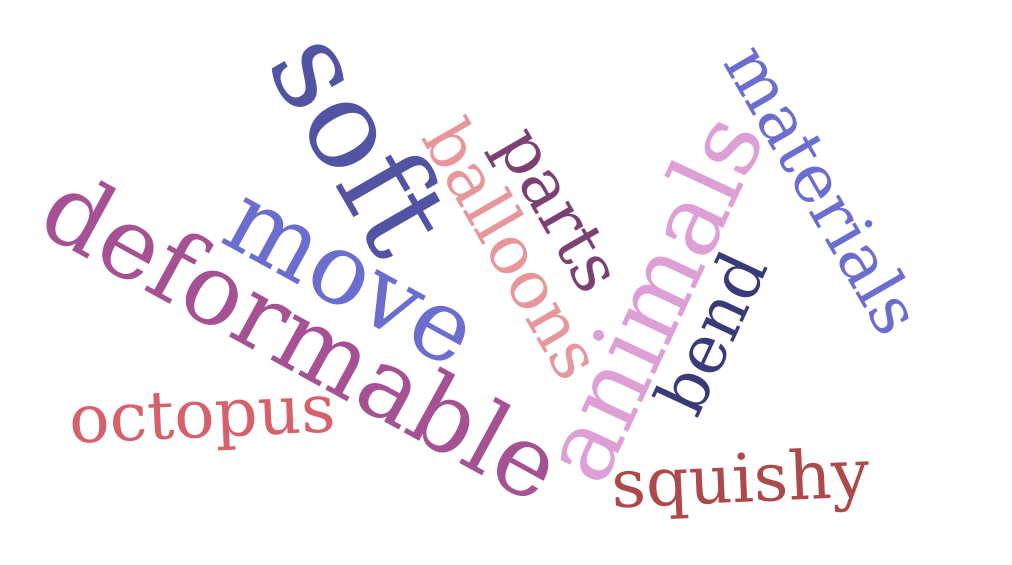Words of soft robotics. Journey through MOZART’s robotics labs, pt 1.
In which we learn the basic “what”, “how”, and “why” of soft robotics through practitioners’ definitions.
In 2023, MOZART’s social sciences and humanities team embarked on a journey across our partnering robotics labs to find out all about soft robotics. We learned that soft robotics is not only based on innovative engineering solutions, but also establishes new relationships between humans and machines, and between nature and technology. During our visit to MOZART’s robotics labs, we organised an interdisciplinary workshop to creatively explore different ways to define and describe soft robotics. The workshops were conducted by Ginevra Sanvitale. In this new series of posts, we present the results.
The first workshop activity focused on providing written definitions of soft robotics targeted towards different audiences: 1) researchers in science, technology, engineering and mathematics (STEM); 2) researchers in social sciences and humanities (SSH); 3) laypeople and the civic society. We asked our colleagues to answer the question “what is soft robotics?”, for each of these groups. We collected a total of 16 definitions per category across the 3 robotics labs of our project partners. We then created word clouds to visualise the results, using Jason Davies’ word cloud generator. We manually polished the definitions, by removing redundant components and by harmonising the wordings. For example, if a definition started with “soft robotics is”, we removed that part, but kept the word “soft” when it was associated with an attribute of the robot, e.g. “made with soft materials”. We harmonised the wordings by turning periphrasis into adjectives, e.g. “that can be deformed” became “deformable”. The only exception is the word “bend”, as it never appeared as an adjective.

The picture above shows the word cloud combining all the three types of definitions. Several definitions highlight the attributes and functionalities of soft robots, described as deformable, flexible, soft, compliant, safe, nonrigid, adaptable, bendable. These features typically refer to the materials used to build soft robots, and to soft robots’ shape. Two more terms significantly emerge from this word cloud: animals, which are often a source of inspiration for the design of soft robots, drawing from the idea of bio-inspired robotics; and humans, especially mentioned in relation to a key concept of soft robotics, that is, an increase of safety. All these words provide an overview of key concepts of soft robotics, most of which can be intuitively understood, e.g. “flexible” and “deformable”. But what happens to our word cloud if we choose a specific target audience for our definition?

What is soft robotics? Definitions for the STEM research community
When it comes to explaining soft robotics to other STEM practitioners, the language becomes quite technical –unsurprisingly. Three terms in particular might sound mysterious to the profanes: “compliant”, which already had a prominent position in the overview map, “Young Modulus”, and “actuation”. In robotics, the concept of “compliance” is the opposite of “stiffness”. Stiffness describes how much a body can resist deformation when a force is applied: the more it resists, the higher is the stiffness and lower the compliance. Compliance is therefore related to the key concept ingrained into soft robotics, namely deformable and flexible structures. “Young Modulus” is a property of solid materials that measure stiffness under certain conditions, thus pointing again at soft robots’ flexibility and deformability. While the first two terms describe physical properties, “actuation” describes an activity. In engineering, actuation means putting a machine into action or motion. A parent concept is that of an “actuator”, the component of a machine which produces motion after receiving energy or signals. STEM-targeted definitions thus tend to highlight the physical and mechanical properties of soft robots.

What is soft robotics? Definitions for the SSH research community
Moving to definitions for the SSH research community, the focus begins to shift from “how” soft robots are made, to “why” they are made. “Humans” and “safe(ty)” have a central role here, as one third of the definitions underline that soft robots can provide safer applications, especially in comparison with existing industrial robotics. The word “environment” does not refer to the natural environment, but to soft robots’ ability to receive and process external stimuli. We find, however, also references to the natural world, highlighting that “animals” inspire soft robotics development. Overall, SSH definitions are not very dissimilar to STEM definitions. The language is more approachable for a non-expert, but terms like “compliant” keep appearing. Several definitions maintain a focus on soft robots’ physical and mechanical properties rather than on their societal significance, as also evidenced by the prominence of the word “materials”.

What is soft robotics? Definitions for lay people
When asked to explain soft robotics to a layperson, such as a friend or family member who knows nothing about robots, our MOZART colleagues became quite creative. Having mostly abandoned the stiffness of technical language, they described soft robots as being “squishy”, looking like “balloons” or an “octopus” or other “animals”. We also learn something new about the physical properties of soft robots: A crucial defining feature is how they can “move” in peculiar ways. Definitions for lay people also stress that soft robots are “deformable”, a stable concept in all the three categories of definitions.
Our first activity in the robotics labs thus revealed key information on the “what”, “how”, and “why” of soft robots. For a robot, being “soft” essentially means being flexible and deformable. These features are related to the materials employed to build the robot, as well as to its structure, shape and actuation method. Soft robots are mostly drawing from bio-inspired robotics, a well-known example being the octopus. Thanks to their peculiar physical and mechanical properties, soft robots can perform different movements and are expected to operate in a safer way when placed in contact with humans.
Ginevra Sanvitale


